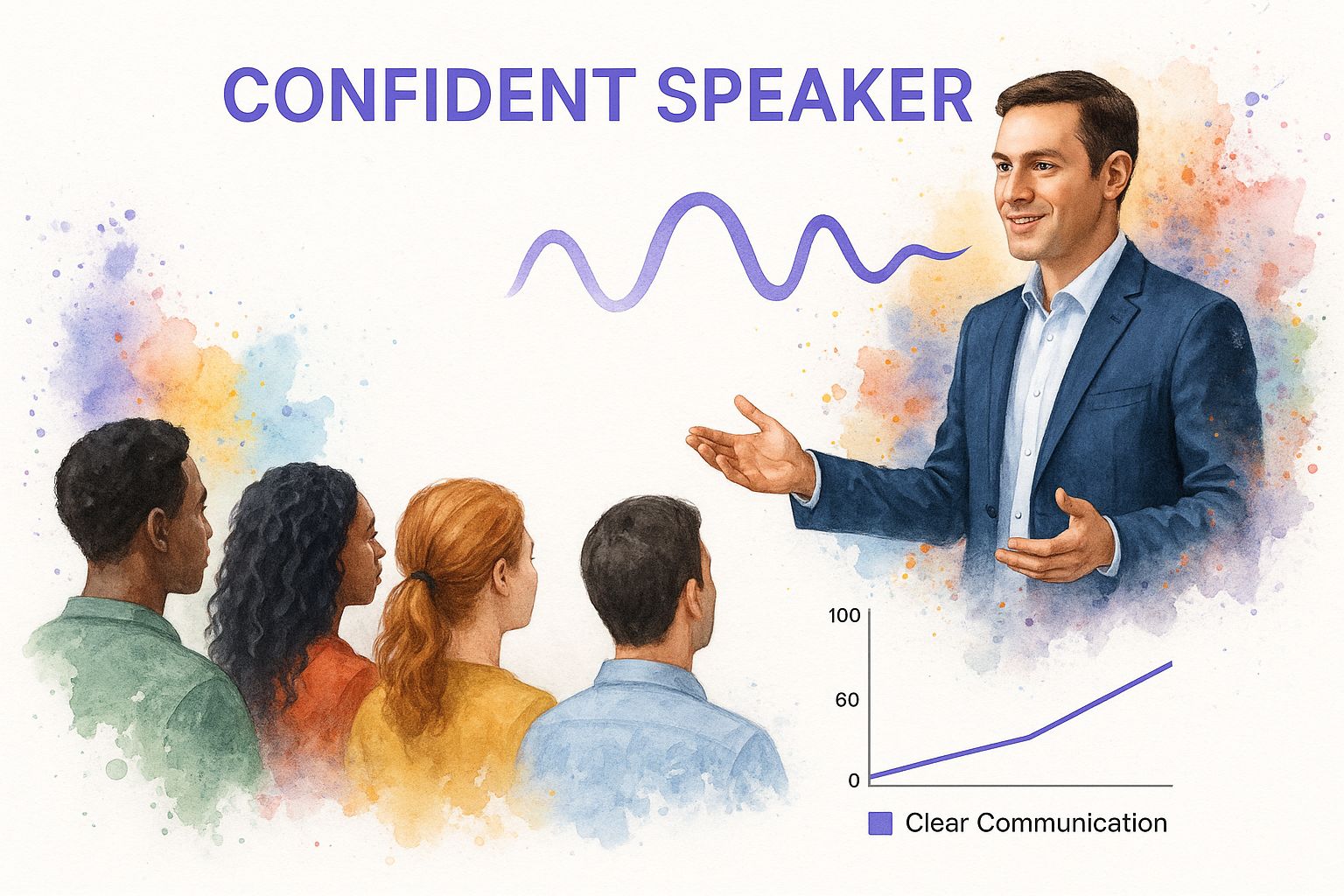Learn English Accent: Proven Tips to Improve Your Pronunciation
Discover effective methods to learn English accent. Get expert tips and AI tools to enhance your pronunciation skills and speak confidently.


Learning an English accent isn't about sounding like someone else—it's about being understood. The real secret lies in focusing on clear pronunciation and a natural rhythm, not chasing some impossible ideal of "perfection."
If you nail the key sounds, really listen to how native speakers talk, and put in the practice, you'll build the kind of confident, clear speech that opens doors in any setting, professional or personal.
Why a Clear English Accent Matters
Have you ever had that frustrating feeling of knowing the right words but still not being understood? When we talk about learning an English accent, the goal isn't to erase your own identity. It's about gaining clarity and confidence, making sure your ideas land exactly as you mean them to.
In your career, clear pronunciation can be a game-changer. It makes you more persuasive in meetings and more engaging during presentations. Socially, it just makes things easier, helping you build genuine connections without the awkwardness of having to repeat yourself. It’s a huge confidence booster. When you're not worried about being misunderstood, you're free to speak up, share your opinions, and dive into conversations.
The Goal Intelligibility Over Perfection
Let’s get one thing straight: there is no single "correct" English accent. English is a global language, spoken by around 1.5 billion people worldwide, and over 70% of them are non-native speakers.
Think about this: research shows that only about 4% of English conversations around the globe are between two native speakers. This just goes to show that being understood by people from different backgrounds is the most valuable skill you can have. You can explore more fascinating statistics about the English language to see just how widespread it is.
The real target here is intelligibility. It’s about being so clear that anyone can understand you easily, no matter where they're from. This image perfectly captures the idea of clear communication building a bridge to a diverse audience.

As the graphic shows, a clear accent is simply a tool for connection. It’s not a test of how well you know the language.
The most successful language learners focus on connection, not correction. Your accent is part of your story; the goal is simply to make that story easier for others to hear and appreciate.
To help you get there, this guide is built on a simple, structured approach. We’ll break down the process into four core pillars, giving you a practical roadmap to refine your pronunciation and speak with the assurance you've been looking for.
This table gives you a sneak peek at the four key areas we'll be diving into.
The Four Pillars of Accent Improvement
| Pillar | Focus Area | Key Outcome |
|---|---|---|
| Pillar 1: Phonetics | Mastering individual sounds, mouth mechanics, and phonemes. | Building the foundational muscle memory for accurate pronunciation. |
| Pillar 2: Listening | Training your ear to recognize the rhythm, stress, and intonation of native speech. | Developing an intuitive feel for the natural flow of English. |
| Pillar 3: Repetition | Using shadowing and drills to internalize new speech patterns. | Making new sounds and cadences second nature. |
| Pillar 4: Practice | Applying new skills in real-world conversations and getting feedback. | Gaining fluency and confidence in spontaneous speech. |
By working through each of these pillars, you'll develop a well-rounded skill set for clearer, more natural-sounding English.
Mastering the Building Blocks of Pronunciation

If you want to sound natural when you speak English, you have to start small. I'm talking about the individual sounds that make up the language. Think of phonetics less like a stuffy academic subject and more like the essential blueprint for your speech. Nailing these core sounds is the first real hurdle to clear on your way to a more natural accent.
From my experience, most learners get tripped up by just a handful of sounds. It's rarely a case of everything being difficult. So, instead of trying to fix your entire accent at once, you'll see much faster progress by zeroing in on the specific sounds that don't exist in your native language.
Targeting Common Problem Sounds
Some English sounds are just plain tricky for non-native speakers. It's a universal struggle, so don't feel discouraged. Let's look at a few of the usual suspects.
- The 'th' sound (θ / ð): A classic. For the 'th' in a word like "think," you gently place the tip of your tongue between your teeth and let air flow out. For the 'th' in "this," you do the exact same thing but add your voice—you should feel a slight buzz.
- The 'l' and 'r' distinction: This one is all about tongue placement. For 'l', the tip of your tongue presses firmly against the ridge just behind your top teeth. But for 'r', your tongue pulls back and curls up in your mouth, never touching the top. Getting a feel for this physical difference is everything.
- Vowel variations: The subtle shift between a short and long vowel can change a word’s meaning entirely. Think about 'ship' versus 'sheep'. The short 'i' in 'ship' is quick and relaxed. The long 'ee' in 'sheep' requires you to spread your lips (almost like a smile) and hold the sound just a bit longer.
Honestly, one of the best things you can do is watch videos of native speakers' mouths up close. Pay attention to the shape of their lips and where their tongue goes. There are tons of phonetic charts online that pair audio with these kinds of visuals, and they are incredibly useful.
Training Your Ear with Minimal Pairs
Okay, so you've figured out how to make the sounds. Now you have to train your brain to actually hear the difference. This is where a fantastic little tool called minimal pairs comes into play. These are simply pairs of words that differ by only a single sound.
Minimal pair drills are like weight training for your ears and mouth. They isolate specific sounds, forcing you to distinguish and produce them accurately, which builds critical muscle memory for clearer speech.
Here's a simple, effective way to practice with them. Let's stick with the tricky 'l' and 'r' sounds.
- Listen: Find an audio clip of someone saying pairs like "light/right," "lice/rice," or "collect/correct." Just listen, over and over.
- Repeat: Now, say them out loud yourself. Don't be shy—really exaggerate the mouth movements for the 'l' and the 'r'.
- Record: Grab your phone and record yourself saying the words. Now play it back and compare it directly to the native speaker's audio.
This kind of focused work does more than just fix your pronunciation. It sharpens your listening skills, making it easier to catch the nuances in fast, conversational English. By building this solid phonetic foundation first, every other part of your accent journey becomes that much easier. There are plenty of resources out there, but at the end of the day, consistent practice is what truly moves the needle.
How to Train Your Ear for Natural Intonation

Think of individual sounds as the bricks of a house. In that case, intonation is the architectural design—the blueprint that gives the structure its shape and flow. Nailing individual sounds is a huge accomplishment, but if you want to sound genuinely natural, you have to capture the music of English. This is all about rhythm, stress, and the natural rise and fall of your voice in conversation.
English is a stress-timed language, which is a crucial concept to grasp. Unlike some languages where each syllable gets roughly equal airtime, English gives more emphasis to certain syllables and words. The unimportant words get compressed, creating a distinct beat. Take the sentence, "I want to go to the store." The bolded words are stressed, while the others are spoken quickly. This rhythm is the bedrock of a natural-sounding accent.
Practical Techniques for Active Listening
To really get a feel for this rhythm, you have to shift from just passively hearing English to actively listening. It’s a completely different skill. You're not just processing the meaning of the words; you're dissecting how they're being said.
One of the most powerful ways to do this is a technique called shadowing. It's simple but incredibly effective. You listen to a native speaker and repeat what they say almost simultaneously, just a split second behind them. The goal isn't just to mimic the words but to copy everything—the pitch, the pauses, the emotion. It feels strange at first, but it builds the muscle memory you need for natural speech patterns.
Your ears are your primary tool for accent improvement. Training them to notice the subtle melodies of English is just as important as training your mouth to form new sounds.
Resources to Guide Your Listening
The trick here is to be selective with your listening material. Don't just throw on a chaotic action movie with mumbled dialogue and explosions. You need clear, consistent speakers to learn from.
Here are a few things that have worked for me and many others:
- Podcasts with solo hosts: Look for shows where one person does most of the talking, like "This American Life" or "The Daily." The narration is usually crisp, well-paced, and perfect for shadowing.
- TV shows with sharp dialogue: Sitcoms and character-driven dramas can be goldmines. Think of shows where the characters have expressive but very clear speech patterns.
- Audiobooks: A good narrator is giving you a masterclass in English intonation for hours on end. A great feature is that you can often slow down the playback speed to make shadowing more manageable when you're starting out.
While you listen, make it a game. Try to pinpoint the stressed words in every sentence. Listen for how the speaker's voice goes up at the end of a question and down at the end of a statement. These are the musical cues you need to internalize. Honing your ability to hear these nuances is a massive part of the journey, and there are many ways to improve your English listening skills that will directly support your accent goals. This is what truly separates a technically correct accent from one that sounds completely natural.
Using AI for Personalized Pronunciation Feedback
https://www.youtube.com/embed/Ni8wTYb30Dw
Technology has given us a fantastic way to get the consistent, targeted feedback we need to really nail down an English accent. Think of AI-powered tools as a personal pronunciation coach that’s ready to go whenever you have a spare moment.
This isn't about replacing conversations with real people. It's about making your solo practice time count. Imagine saying a sentence and instantly getting an objective breakdown of which sounds you hit perfectly and which ones need a little more work. That's a level of detail that’s almost impossible to achieve on your own.
How AI Can Fast-Track Your Learning
The real magic of using an AI coach is the immediate, specific correction it provides. When you're practicing by yourself, it's incredibly easy to keep making the same mistakes without ever knowing it. AI completely breaks that cycle.
An app like TalkEasy, for example, analyzes your speech right down to the nitty-gritty details. You speak a phrase, and the tech instantly flags the exact spots for improvement. This means you can:
- Pinpoint specific errors: Finally see if you're tripping up on the 'th' sound, getting the vowel in 'ship' wrong, or putting the stress on the wrong syllable.
- Actually track your progress: Watching your accuracy scores climb over time is a massive confidence boost and keeps you motivated.
- Build correct muscle memory: By practicing and correcting those tiny mistakes over and over, you’re training your mouth to make the right sounds automatically.
This data-driven approach takes all the guesswork out of the equation. You know exactly what to work on each time you practice, making sure every minute is spent strengthening your weakest spots.
Weaving AI into Your Daily Routine
The demand for English skills has absolutely exploded. Right now, about 1.75 billion people worldwide are learning or using English, making it the most studied second language on the planet. This boom, particularly in Asia and emerging markets, is being met by a new wave of online platforms and AI tools that make learning more accessible than ever. You can see just how massive this trend is by looking into these global English learning trends.
Fitting these tools into your life doesn’t mean you have to block off hours of your day. The secret ingredient is consistency.
AI pronunciation tools don’t just correct you; they empower you. By providing objective, real-time data on your speech, they turn frustrating guesswork into a clear, actionable path toward accent improvement.
Instead of cramming for a few hours once a week, try to find short pockets of time every day. Even 15 minutes a day of focused pronunciation drills can lead to very real, noticeable improvements in just a few weeks. This micro-learning approach is especially effective for beginners trying to build a solid foundation. In fact, our guide on English speaking practice for beginners has more ideas for creating a routine that actually sticks.
When you combine this kind of AI feedback with the listening and phonetic skills we've already covered, you create a powerful system for truly refining your accent. You're no longer just speaking more—you're speaking better.
Bringing Your New Accent into Real Conversations
All the drills and listening exercises are like practicing in the gym—they build the muscle. But now it's time to actually play the game. This is where you take everything you've learned and apply it to real, spontaneous conversations.
Honestly, it can feel a little intimidating. The fear of stumbling over a word or having someone misunderstand you is completely normal.
The trick is to shift your mindset. For your first few real-world chats, don't worry about sounding like a native speaker. Your only goal should be clear communication. Did the other person get your message? If so, that's a huge victory. When you focus on connecting with someone instead of achieving accent perfection, the pressure just melts away.
Finding the Right Practice Partners
Conversation is the ultimate feedback loop. It instantly tells you what's working and what isn't. But to make it effective, you need the right people to talk to—partners who are patient and can give you a little nudge in the right direction without crushing your confidence.
Once you find a language exchange partner or a conversation group, be direct about what you're trying to do. A simple, "Hey, I'm really working on my accent. If I say anything that sounds a bit off, could you let me know?" does wonders. It gives them permission to help you in a way that feels supportive, not critical. You'd be surprised how many people are happy to help someone putting in the effort. Our guide on English conversation practice online has some great ideas for finding these kinds of partners.
The point of a conversation isn't to perform a perfect accent. It's to connect with another human being. When you make that connection the priority, the confidence comes naturally, and your accent improves right along with it.
Start small. I always recommend low-stakes situations first. Ordering a coffee, asking a stranger for directions, or making a quick phone call to a store are perfect. They're short, manageable interactions that let you test your clarity without much pressure.
Every time someone understands you, it’s a small win that builds momentum. It's proof that you can do this, and that's the best confidence booster there is. Each successful exchange makes the next one feel a little less scary, helping to lock in the new habits you've worked so hard to build.
Common Questions About Learning an English Accent
When you start working on your accent, it's natural for questions to pop up. Let's tackle some of the most common ones I hear from learners, with answers based on years of real-world experience.
How Long Does It Take to Improve an English Accent?
This is the big one, isn't it? The honest answer is that there’s no magic number. It really depends on your native language, how much you practice, and your starting point.
That said, with dedicated, consistent work, most people see a real, noticeable difference in their clarity within three to six months. The secret is consistency, not cramming. A focused 30 minutes every single day will get you much further than a marathon session once a week.
Should I Learn an American or British Accent?
A fantastic question. My advice is always to pick the accent that best fits your life.
- Where will you use it? If you work with a team in New York or plan to study in London, the choice is pretty clear. Let your environment be your guide.
- Clarity over perfection: Remember, both standard American and British English are understood globally. The real prize is being understood, not sounding like you were born in a specific city.
Pick one and stick with it for consistency, but don't get so hung up on it that you forget the main goal: communicating clearly and confidently.
Your accent is part of your identity and personal history. The goal isn't accent elimination but accent modification—refining your speech so your message is heard clearly and confidently by anyone, anywhere.
Is It Possible to Completely Lose My Native Accent?
While it’s technically possible for some, it’s incredibly rare and shouldn't be the goal. A better way to think about it is adding a new communication tool to your skillset, not trying to erase your linguistic background.
Your accent tells the story of who you are and where you've been. Success isn't about sounding like someone else; it's about speaking with confidence, knowing that people aren't struggling to understand your ideas. That's what really matters.
What Is the Biggest Mistake Learners Make?
By far, the most common pitfall is getting obsessed with individual sounds while completely ignoring the music of the language—the rhythm, stress, and intonation.
You could pronounce every single consonant and vowel perfectly, but if your delivery is flat and robotic, you'll still sound unnatural. It’s absolutely critical to spend just as much time listening to and mimicking the flow of English as you do on phonetic drills.
Listen for the melody. Notice which words are stressed in a sentence and how a speaker's voice rises and falls. This is what makes speech sound authentic and engaging to a native listener.
Ready to turn all this theory into real progress? TalkEasy gives you instant, AI-powered feedback to help you speak English more clearly and confidently in just 15 minutes a day. Start your journey toward a more natural accent by visiting the TalkEasy website.